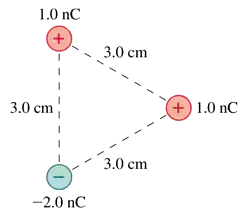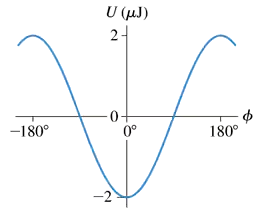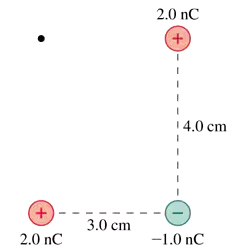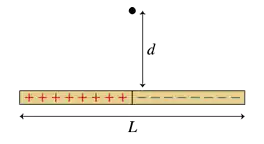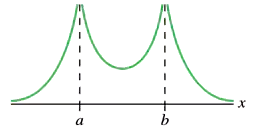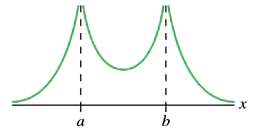 Back
BackProblem 1
The electric field strength is 50,000 N/C inside a parallel-plate capacitor with a 2.0 mm spacing. A proton is released from rest at the positive plate. What is the proton's speed when it reaches the negative plate?
Problem 4
An electron is released from rest at the center of a parallel-plate capacitor that has a 1.0 mm spacing. The electron then strikes one of the plates with a speed of 1.5×106 m/s. What is the electric field strength inside the capacitor?
Problem 5
What is the electric potential energy of the group of charges in FIGURE EX25.5?
Problem 7
Two positive point charges are 5.0 cm apart. If the electric potential energy is 72 μJ, what is the magnitude of the force between the two charges?
Problem 8
Three charged particles are placed at the corners of an equilateral triangle that has edge length 2.0 cm. One particle has charge +3.0 nC and a second has charge +6.0 nC. What is the third charge if the electric potential energy of the three charged particles is zero?
Problem 10a
FIGURE EX25.10 shows the potential energy of an electric dipole. Consider a dipole that oscillates between ±60°. What is the dipole's mechanical energy?
Problem 11
What is the speed of an electron that has been accelerated from rest through a potential difference of 1000 V?
Problem 14
What potential difference is needed to accelerate an electron from rest to a speed of 2.0×106 m/s?
Problem 15b
A proton with an initial speed of 800,000 m/s is brought to rest by an electric field. What was the potential difference that stopped the proton?
Problem 16a
An electron with an initial speed of 500,000 m/s is brought to rest by an electric field. Did the electron move into a region of higher potential or lower potential?
Problem 17
In proton-beam therapy, a high-energy beam of protons is fired at a tumor. As the protons stop in the tumor, their kinetic energy breaks apart the tumor's DNA, thus killing the tumor cells. For one patient, it is desired to deposit 0.10 J of proton energy in the tumor. To create the proton beam, protons are accelerated from rest through a 10,000 kV potential difference. What is the total charge of the protons that must be fired at the tumor?
Problem 18
A 250 pg dust particle has charge −250e. Its speed is 2.0 m/s at point 1, where the electric potential is V₁=2000 V. What speed will it have at point 2, where the potential is V₂=−5000 V? Ignore air resistance and gravity.
Problem 20b
A student wants to make a very small particle accelerator using a 9.0 V battery. What speed will an electron have after being accelerated from rest through the 9.0 V potential difference?
Problem 22a
A 3.0-cm-diameter parallel-plate capacitor has a 2.0 mm spacing. The electric field strength inside the capacitor is 1.0×105 V/m. What is the potential difference across the capacitor?
Problem 22b
A 3.0-cm-diameter parallel-plate capacitor has a 2.0 mm spacing. The electric field strength inside the capacitor is 1.0×105 V/m. How much charge is on each plate?
Problem 23a
Two 2.00 cm×2.00 cm plates that form a parallel-plate capacitor are charged to ±0.708 nC. What are the electric field strength inside and the potential difference across the capacitor if the spacing between the plates is 1.00 mm?
Problem 24b
Two 2.0-cm-diameter disks spaced 2.0 mm apart form a parallel-plate capacitor. The electric field between the disks is 5.0×105 V/m. An electron is launched from the negative plate. It strikes the positive plate at a speed of 2.0×107 m/s. What was the electron's speed as it left the negative plate?
Problem 27b
What are the potential differences ΔVₐᵦ=Vᵦ−Vₐ and ΔV𝒸ᵦ=Vᵦ−V𝒸?
Problem 28
A 1.0-mm-diameter ball bearing has 2.0×109 excess electrons. What is the ball bearing's potential?
Problem 29a
In a semiclassical model of the hydrogen atom, the electron orbits the proton at a distance of 0.053 nm. What is the electric potential of the proton at the position of the electron?
Problem 29b
In a semiclassical model of the hydrogen atom, the electron orbits the proton at a distance of 0.053 nm. What is the electron's potential energy?
Problem 31
What is the electric potential at the point indicated with the dot in FIGURE EX25.31?
Problem 33
Two small charged spheres are 5.0 cm apart. One is charged to +25 nC, the other to −15 nC. A proton is released from rest halfway between the spheres. What is the proton's speed after it has moved 1.0 cm?
Problem 34
Four small spheres, each charged to +15 nC, form a square 2.0 cm on each side. From far away, a proton is shot toward the square along a line perpendicular to the square and passing through its center. What minimum initial speed does the proton need to pass through the square of charges?
Problem 35
The two halves of the rod in FIGURE EX25.35 are uniformly charged to ±Q. What is the electric potential at the point indicated by the dot?
Problem 36b
Two point charges qₐ and qᵦ are located on the x-axis at x=a and x=b. FIGURE EX25.36 is a graph of V, the electric potential. What is the ratio |qₐ/qᵦ|?
Problem 36c
Two point charges qₐ and qᵦ are located on the x-axis at x=a and x=b. FIGURE EX25.36 is a graph of V, the electric potential. Draw a graph of Eₓ, the x-component of the electric field, as a function of x.
Problem 37
Two point charges 2.0 cm apart have an electric potential energy −180 μJ. The total charge is 30 nC. What are the two charges?
Problem 38a
A −10.0 nC point charge and a +20.0 nC point charge are 15.0 cm apart on the x-axis. What is the electric potential at the point on the x-axis where the electric field is zero?
Problem 39
A +3.0 nC charge is at x=0 cm and a −1.0 nC charge is at x=4 cm. At what point or points on the x-axis is the electric potential zero?

